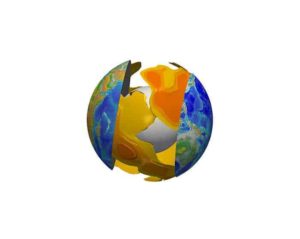
A small amount of molten rock located under tectonic plates encourages them to move. This is what scientists from the Laboratoire de géologie de Lyon: Terre, planètes et environnement (CNRS/ENS de Lyon/Université Claude Bernard Lyon 1) have recently discovered. Their new model takes into account not only the velocity of seismic waves but also the way in which they are attenuated by the medium they pass through. The velocity of tectonic plates near the surface is thus directly correlated with the quantity of magma present. This research is published on October 21, 2020 in Nature.
The lithosphere, the outer part of the Earth, is made up of the crust and part of the upper mantle. It is subdivided into rigid plates, known as tectonic or lithospheric plates. These move on a more fluid layer of the mantle, the asthenosphere. The lower viscosity of the asthenosphere allows the tectonic plates to move around on the underlying mantle, but until today the origin of this low viscosity remained unknown.
Seismic tomography produces three-dimensional images of the Earth’s interior by analysing millions of seismic waves recorded at seismological stations spread across the surface of the globe. Since the 1970s, seismologists have analysed these waves with a view to identifying a single parameter: their propagation speed. This parameter varies with temperature (the colder the medium, the faster the waves arrive), composition, and the possible presence of molten rocks in the medium the waves pass through. Seismologists from the Laboratoire de géologie de Lyon: Terre, planètes et environnement (CNRS/ENS de Lyon/Université Claude Bernard Lyon 1) instead studied another parameter, wave attenuation, alongside the variation in wave propagation speeds. This analysis, which provides new information on the temperature of the medium traversed by the waves, makes it possible to ascertain the quantity of molten rock in the medium the waves pass through.
Their new model made it possible, for the first time, to map the amount of molten rock under tectonic plates. This work reveals that a small amount of molten rock (less than 0.7% by volume) is present in the asthenosphere under the oceans, not only where this was expected, i.e. under ocean ridges and some volcanoes such as Tahiti, Hawaii or Reunion, but also under all oceanic plates. The low percentage of molten rock observed is enough to reduce the viscosity by one or two orders of magnitude underneath the tectonic plates, thus “decoupling” them from the underlying mantle. Moreover, the seismologists from Lyon observed that the amount of molten rock is higher under the fastest-moving plates, such as the Pacific plate. This suggests that the melting of the rocks encourages the plates to move and the deformation at their bases. This research improves our understanding of plate tectonics and how it works.
Reference:
Eric Debayle, Thomas Bodin, Stéphanie Durand, et Yanick Ricard. Seismic evidence for partial melt below tectonic plates. Nature, October 21, 2020 DOI: 10.1038/s41586-020-2809-4
Note: The above post is reprinted from materials provided by CNRS.










